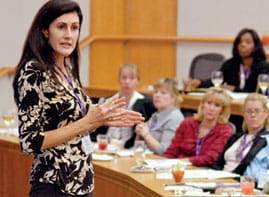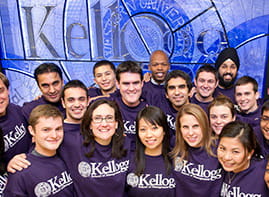Since moving to the converted warehouse space owned by SOSV, another of San Francisco’s incubators that gives young professionals with jeans and flat-bill hats a place to toil on their Macbooks, Front Row Education has seen remarkable growth.
Sidharth Kakkar had no idea at the time, but the genesis of his multimillion-dollar venture capital-backed education startup began when he was 14 years old. As a freshman at West Windsor High School in New Jersey in 2000, Kakkar took a programming course, and “I remember in the first week, my teacher started talking about hexadecimal numbers. And I was just so freaked out. And I was like, I’m just going to quit this because there is no way I’m going to understand what he is talking about.”
But Kakkar’s parents had other plans. They encouraged him to stick it out a little longer. And they were right.
“By the end of the first month, I was in love,” Kakkar, now 30, tells
Poets&Quants in a co-working space his education software startup,
Front Row Education, is currently over-running. Since moving to the converted warehouse space owned by SOSV, another of San Francisco’s incubators that gives young professionals with jeans and flat-bill hats a place to toil on their Macbooks, Front Row Education has seen remarkable growth. In two years, Kakkar and his co-founder, Alexandr Kurilin, have increased their staff size from four to 35 and nabbed seed and Series A rounds in VC support totaling $6.6 million. Front Row’s two apps, which help students from kindergarten through eighth grades improve their math and language arts skills, can be found in more than 41,000 schools in all 50 U.S. states, seven U.S. territories, and more than 25 countries. All told, some 5.3 million students are using the apps.
LEARNING WEBSITE PROGRAMMING FROM A HOMELESS MAN IN A NYC STARBUCKS
Front Row’s success can be traced to (at least) two unlikely — and profoundly random — occurrences. The first was Kakkar’s unforeseen love affair with programming. “I was a nerd without any friends, so I had plenty of time to do that stuff,” he laughs, noting that he became “enamored” with building computer games and projects after that freshman-year class, then took the school’s other programming options before enrolling in the computer science department at Carnegie Mellon University in Pittsburgh.
“I never thought I wanted to be a career programer,” Kakkar now says. “I just really enjoyed doing it, so it felt like the thing to study.” True to those sentiments, after graduation he took a position with Goldman Sachs as an analyst on Wall Street. “I wanted to live in New York and I wanted a job,” he says of his decision. But he quickly became bored, an he missed programming. “In undergrad, you don’t learn the practical stuff, you learn more theoretical stuff — at least, I did,” Kakkar says. “I didn’t know how to make a website after undergrad.”
So he did what any bored programmer trapped in an investment banker’s career would do: He hired a homeless man on Craigslist to teach him web design.
‘NOTHING IS $10 AN HOUR IN NEW YORK CITY’
Cue random occurrence two. After putting an ad on New York City’s Craigslist page asking for web programming training, Kakkar only heard from people wanting to build him a website. But Kakkar wanted to learn how to build. “There weren’t really any programming bootcamps at that time,” he recalls, noting the year: 2008. “There was no real way to learn web programming.”
That is, until a homeless man wanting $10 an hour replied to his ad. “This is New York City,” Kakkar says, still sounding surprised. “Nothing is $10 an hour in New York City. He had a laptop, backpack, he often slept in shelters, and he helped me at Starbucks. Because, you know, they have free Internet there. He taught me how to make a web app in PHP (hypertext preprocessor).”
But as mysteriously as the programming guru came into Kakkar’s life, he left. “We had done 14 hours together and on the 15th lesson he didn’t show up,” Kakkar remembers. “And I never heard from him again.”
THE ENTRANCE INTO B-SCHOOL
Kakkar had learned enough to begin making random websites. He also was shaped by living through his position at Goldman Sachs during the economic crisis of 2007 and 2008.
“You learn more from the bad times than you do from the good times,” says a still optimistic and upbeat Kakkar. “Right away in 2007, things started to go south. And then in 2008, things started to go really south. There were days and weekends we came in to run a bunch of risk analysis stuff to make sure our books would survive if X event happened or Y event happened. And that stuff is cool. At the time it wasn’t cool. At the time it was extremely stressful. But in retrospect, it’s cool because you don’t get to learn that from such an intense situation every day, you know?”
Still, by 2010, Kakkar had become unsure about what he wanted to do in his professional life. So he did what he says many in his position do — he applied to elite MBA programs. After being accepted into the full-time MBA program at Northwestern’s Kellogg School of Management, he enrolled in the fall of 2010. “I wanted to be a consultant because it sounded cool,” Kakkar says. But his admissions essays said differently. Kakkar wrote that he wanted to eventually start and run his own software company. “That was always the ultimate vision,” he recalls.
Kakkar stayed the consulting course at first, notching a coveted summer internship at Bain. But when he returned to Kellogg for his second year, he found himself “hacking” things together again. He created an online community called 10pens.com that allowed users to receive feedback on writing and application materials. He created another app with a professor at Northwestern that helped people meet up for social events. “Random stuff like that,” Kakkar says. “Kellogg was really good for giving me room to experiment. Business school isn’t as taxing as a taxing job. But if you are going to try to make the most of it, it will give you room to make the most of it. You can totally coast through if you want, but you can also take advantage of the people, professors, and things around you.”
THE ENTREPRENEURIAL MAGIC OF ‘TORQUE’
Kakkar believes two things led to what happened next. Both stem from what Kakkar says his friends describe as his “torque.”
“It’s this idea that everything I do has an impact on the outcome that I’m going to have,” Kakkar, whose father has run a food processing business from New Jersey and India for the past 30 years, explains. “And the second part is, the outcome of my work has to have meaning. When you start a company, that is maximum torque. Everything you do has an effect on the outcome.”
Aiming for maximum torque and meaning, Kakkar found a natural fit in education, always an important — and controversial — topic in the U.S.
“The reason education appeals to me is that I find it a high-leverage place that you can make a difference in society,” Kakkar says. “What I mean by that is, there are a lot of fifth-grade classes out there, for example, with kids who are working at a first- or second-grade level.”
GOING BACK TO (ELEMENTARY) SCHOOL
Kakkar first learned of the state of learning in U.S. public schools by listening to his teacher friends lament about how all of the kids in their classrooms — often as many as 30 in each class — were at different levels. “In a classroom of 30 kids, not all of them are in the same place,” Kakkar says. “And so how does one teacher reach all of the kids? To me, that sounded like a problem a computer program could fix.”
Almost a year after Kakkar graduated with his MBA — and after the launch of another failed vocabulary app — he spent a little more than a month in Gwynns Falls Elementary School in Baltimore testing out a math app. Starting in a friend of a friend’s classroom, Kakkar began testing a way to automate math problems to each student’s specific level. Kakkar soon experienced first-hand what his teacher friends had told him. According to Kakkar, it’s “very likely” about a third of fifth grade students in a classroom are at least “two or three grade levels” behind.
“That teacher is going to have so much trouble getting those students up to speed,” says Kakkar. “Because, one, they are behind. Two, they are behind in a lot of different ways. And three, she has students that aren’t as behind and are going to be easier to get to grade level. Those kids are probably going to get ignored.”
As those kids get ignored, Kakkar explains, they just start shooting for D’s on tests. And then?
“You start to be the person who walks around saying, ‘I’m not a math person,'” he explains. “Or worse, saying, I’m not a smart person. That’s an awful thing to happen to someone.”
FROM A BALTIMORE ELEMENTARY SCHOOL TO A SILICON VALLEY ACCELERATOR
So Kakkar spent April of 2013 going into Gwynns Falls and installing the latest version of his software onto the school’s iPads. Then he pushed the iPad cart from classroom to classroom and had the students test out the app. “I got to hang out with the teachers. I got to work with these kids and help them learn. I got to see what they think, what they like, what they don’t like, what resonates with them,” Kakkar says. “And then I got to go home and hack together a bunch of more stuff.”
Each night, Kakkar went home and tweaked the app. Now, almost four years later, he says a lot of the key pieces still used on Front Row’s math app were born in that Baltimore elementary school.
Sensing they were onto something, Kakkar and Kurilin were accepted into the Imagine K12 incubator in San Francisco’s Bay Area. Now part of the Y-Combinator Ed Tech program, Imagine K12 gave the two a little funding and a space to further test their software. They were also able to hire a former teacher to help with the content. “He was looking for his next adventure,” Kakkar says of the teacher, their first official employee. He pauses. “And he agreed to work for almost no money,” he adds.
TRANSITIONING FROM AN ‘EXPENSIVE HOBBY’ TO AN ACTUAL BUSINESS
With the math software in place, they sent the math app to about 100 teachers, mostly in the San Francisco Bay Area along with a few in Wisconsin and New Jersey. And it exploded. “You could actually see these random splotches in the country where it was spreading,” Kakkar says.
“I think the mistake people sometimes make is thinking of teachers as different from any other kind of professional,” Kakkar continues. “Teachers are no different from programmers or designers.” For example, when designers or programmers find a tool that makes their jobs easier, Kakkar explains, they get excited about the tool and share it with all of their programmer and designer friends. “That’s exactly the Front Row story,” Kakkar says. “We got in front of a few teachers and they really liked it. So they told a bunch of other teachers about it, who told a bunch of other teachers about it.”
The early popularity led to a $1.3 million Seed round in early 2014. But the team stayed small because they weren’t actually selling anything. The trio was continuing to perfect the free app before unveiling a paid version. So they didn’t hire a fourth team member until the middle of 2014.
“As another education tech entrepreneur once put it, when you give software away to a lot of people for free, that is just a really expensive hobby,” Kakkar laughs. “So all we had at that point was a really expensive hobby. And you don’t pour gas on the fire at that point.”
PRODUCT ROLLOUT, REVENUE STREAM IN
In March of 2015, Front Row hired its fifth employee and then raised a much more substantial $5.3 million Series A round in May of the same year. That was also when they rolled out their paid product and started seeing some revenue. Since, Front Row has taken off. They have introduced a language arts app and Kakkar says in the next few months they will be rolling out a social studies app. In a few months, they’ll also be moving their 35 employees to a new office space in San Francisco. “We’ve spent very little of our Series A money. And that means we can really increase the team size,” Kakkar explains.
Still, the growth hasn’t come without some pains. For instance, the team went at least two years without selling anything. “That’s a really scary thing, because until you start selling something, you don’t know if this is a business or just a way to burn money,” Kakkar says, noting they are still set more on growing the products more than profitability. So until then, this was just an efficient vehicle for burning money.”
Kakkar says they tried at least 10 different pricing schemes to meet wide-ranging school district and state budgets that would largely be paying for the product. Pricing models varied from fixed prices for an entire school to variable priced components of the product to tier pricing to bundled pricing to hybrids of almost all of those models. “We’ve tried so many things,” he concedes.
‘EXPERIMENT AS MUCH AS YOU CAN’
While the free product is available for all teachers, the paid product seems to be pricey. Teachers may schedule meetings with Front Row Education for quotes. Kakkar says a “general ballpark” figure is a few hundred dollars for the math application — though a quick Internet search reveals some teachers using crowdfunding to raise thousands of dollars for the program. Still, Kakkar maintains, the free app remains a focus and is what drives the paid product.
As for the lesson for current and future business students, Kakkar says to keep trying and expect failure.
“Try stuff in business school. Experiment as much as you can. Try building things,” he advises. “Maybe it will become the thing you build. But there is a really good chance it won’t. The experimentation is what taught me the most.”






